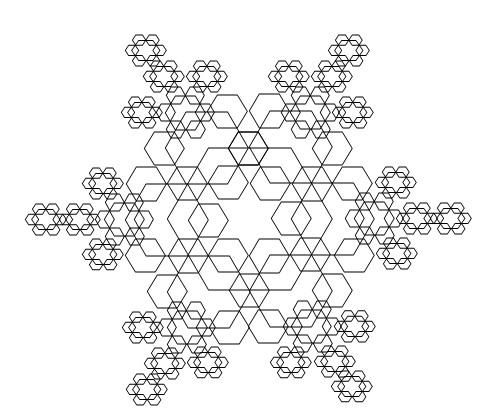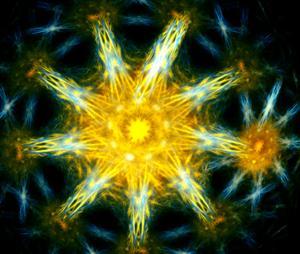| Complexity level: | 8 |
| Project cost ($): | 20 |
| Time required: | 1 hour to prepare, 1 day for research |
| Material availability: | Easily found |
| Safety concerns: | Handle the paper cutter with care to avoid injury Adult assistance is required. |
Hypothesis
Fractals can be used to make beautiful shapes and images.
Overview
Fractals
A fractal is a repetition of a simple geometric shape, at larger or smaller sizes repetitions of itself, in order to create a pattern or a shape based on certain rules. Based on a set of rules, the simple geometric shape can grow from one level to another, by adding on more shapes to the pattern in the previous level. This process can be repeated an infinite number of times.
Fractals can be used to mathematically reproduce on a computer various forms, shapes and structure that are found in nature. Very complex, colorful and beautiful images can be created on a computer using simple mathematical formulae.
Shapes like squares, rectangles, triangle or a circle can be mathematically defined.Until the discovery of fractals, objects found in nature like a leaf, flowers, clouds, mountains, snowflakes and even our galaxy could not be mathematically represented.
Fractals have many unique features and one of them is their infinite nature. Fractals can be used to expand to infinitely large coordinates from where we are now, to the edge of the universe. They can also be magnified to a microscopic level to view infinite details within the fractal image.
Scientific Terms
Materials
The materials required for our research:
- 1 large sheet of graph paper
- 1 ruler
- 1 paper cutter
- 1 thick (1mm) cardboard A4 size
- 1 mechanical pencil
Procedure
1. A hexagon template is made using a small sheet of cardboard. Draw and cut out 6 hexagons of different sizes using the paper cutter. The suggested length of the hexagon sides are 160mm, 80mm, 40mm, 20mm, 10mm and 5mm.
2. Using the hexagon template, draw a160mm hexagon in the center of the paper as shown in figure 1 below. This is the first stage of the fractal image.
3. Proceed to draw the 80mm hexagons on the corners of the hexagon using the template. There will be 6 hexagons drawn as shown in figure 1. This is the completion of the second stage of the image.

4. Proceed to draw 40mm hexagons around the six corners of the 6 hexagons that were drawn in the second stage. There will be 36 hexagons drawn this time. The third stage of the fractal image is now completed.
5. Proceed to add on the remaining 3 sizes of hexagons using your imagination. An example is given below in figure 2. The positioning of the hexagons can be done selectively to obtain a specific design or shape.


Results
The results show that beautiful designs and creations that were previously unseen and unimaginable, can be created using fractals. The design in Figure 2 below is one such example of fractals using the simple hexagon shape in only 6 stages.
Figure 2 – Example 6th stage fractal design using the hexagon shape

Conclusion
The hypothesis that fractals can be used to make beautiful shapes and images is proven to be true. The image shown in figure 2 may yet be further expanded to make it look even more beautiful and intricate. Adding colors will make it look even more attractive.
In nature fractals can be used to define both chaos and harmony. Fractals can be used to explain the geometric shapes of a storm cloud, the silhouette of mountains and of raging hurricanes. Similarly, looking at the fern leaf, broccoli or the strawberry, we can observe the same fractal working in symmetry.
Living organisms may be said, in a sense, to befractals made from a basic cell. These cells are also fractals made from amino acids. The amino acids are also fractals made from atoms at the lowest level!
Also consider
Try using other basic shapes like a square, circle or triangle of different sizes.
Try to complete your research using a computer to simulate the growth of the fractals. Add colors to make the final result look more attractive.
References
Fractal - http://en.wikipedia.org/wiki/Fractal
Fractals – an introduction - http://arcytech.org/java//fractals/intro.shtml
What are fractals? - http://www.fractalarts.com/SFDA/whatarefractals.html

